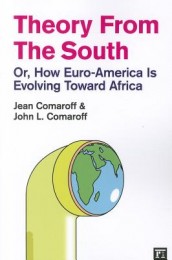This volume opens with an amazing epigraph from South Africa’s Ministry of Higher Education and Training, part of which reads, “We should not only be consumers of theory from the developed world. We should become more active producers of social theory….” This quotation alone is almost enough to convince me of the book’s premise: that South Africa and the rest of the “global South” lead the world in new theory and practice. After all, how many governments actively promote the generation of social theory as part of their agenda? (The possible exception of the French aside.) In keeping with their interest in the flows and hiccups of capital in a post-colonial, globalized world, the authors, Jean Comaroff and John L. Comaroff, immediately frame their conversation in these terms, opening with a reminder of how Western thought has always treated the rest of the world as a “reservoir of raw fact” (1) that can be capitalized upon. As the volume’s title indicates, the anthropologists’ intent is to reverse the usual assumption that theory and praxis filter down from the West to the rest and instead to demonstrate how the South produces much of what is new. This somewhat romantic notion does not, however, work as a corrective to European and American default thinking for a number of reasons, almost all of which they themselves anticipate. For instance, the problem of the word “evolving” in the title. Of course, we know (if we have properly read our Darwin) that evolution is not teleological—it consists of mistakes and mutations as much as it does improvements and advantages. Comaroff and Comaroff address the problem early and directly:
To the degree that the making of modernity has been a world-historical process, it can as well be narrated from its undersides as it can from its self-proclaimed centers—like those maps that, as a cosmic joke, invert planet Earth to place the south on top, the north below. But we seek to do more than just turn the story upside down thus to leave intact the Manichean dualism that holds Euro-America and its others in the same, fixed embrace. Or to displace an established telos with its opposite, leaving teleology itself intact. We also seek to do more than note that many of the emergent features, the sublimated structures, and the concealed contradictions of capitalist modernity were as readily perceptible in the colony as in the metropole. Or that the former was often a site of production for the ways-and-means of the latter. What we suggest, in addition, is that contemporary world-historical processes are disrupting received geographies of core and periphery, relocating southward—–and of course, eastward as well—some of the most innovative and energetic modes of producing value. And, as importantly, part or whole ownership of them. (7)
Despite these best intentions, the book does succumb to a sort of reverse teleology. Describing African modernity as a history “not running behind Euro-America, but ahead of it” (12) makes the unfolding of history sound like a race, as does asking “whether the West recognizes that it is playing catch-up in many respects with the temporality of its others” (14). The basic impulse here, though, is sound and admirable: not only to redeem the contributions of the global South to modernity and postmodernity, but to insert them into the dominant narrative of those histories.
Comaroff and Comaroff see the effects of global economic processes to be most visible and most spectacular in the South. This is where they “tend to most graphically manifest themselves” (13). And they lament “our failure to recognize in Africa, Asia, and Latin America the traces of things about to happen, things sometimes destructive, sometimes productive, sometimes a mixture of both” (17). That tricky pronoun in “our failure” slips in a few times over the course of the book. We have to ask who is part of that “our,” whose idea of settled is being made strange (19), and whose ordinary is being stripped “of its self-evident ordinariness” (19). Very careful about trying to avoid falling into binaries of the West and the rest, or the West and its others, the authors are not always careful enough about specific language choices and so, ironically, there are moments in which they reinforce the very hierarchies they hope to trouble.
I remain unconvinced that the essays in Theory from the South need to be drawn together by a single, overarching argument. As the authors point out in their Editorial Note, With the exception of Chapters 1 and 6, the essays in this volume have all been published elsewhere” (191). Many of these essays are important and useful in their own right and do not need to be yoked into service in a compilation in which the main claim sometimes feels artificially and arbitrarily imposed on them. After the introductory essay in Chapter 1
Helen Kapstein is tenured in the English Department at John Jay College, The City University of New York. She earned her PhD in English and Comparative Literature from Columbia University. Her areas of interest include postcolonial and contemporary British literatures, cultural and media studies, and southern African literature and culture. Her current project is “Coffins, Corpses and Wheelchairs”: Mass Hysteria and Postcolonial Constitutions.

